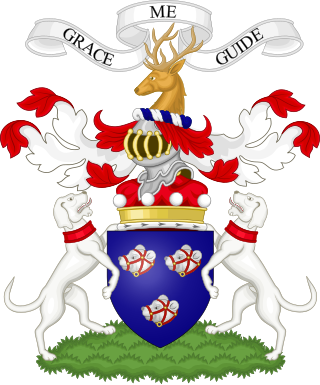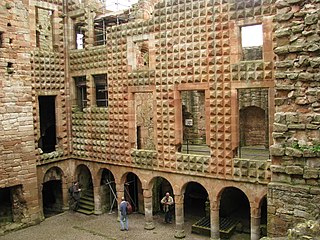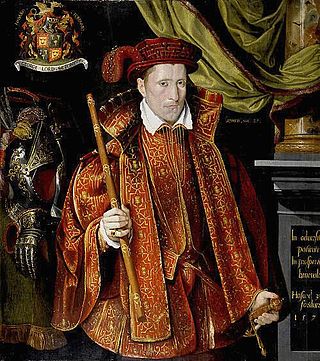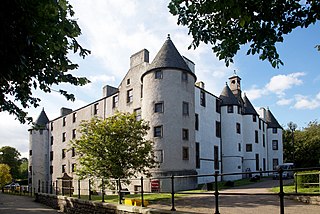Related Research Articles

Francis Hay, 9th Earl of Erroll was a Scottish nobleman. A convert to Catholicism, he openly conspired with the king of Spain to try to unseat the Protestant Queen Elizabeth.

William Douglas, 10th Earl of Angus was a Scottish nobleman. He was the son of William Douglas, 9th Earl of Angus (1533–1591). He was a direct descendant of King James I through his paternal grandmother, Agnes Keith, a daughter of William Keith, 3rd Earl Marischal.

John Maitland, 1st Lord Maitland of Thirlestane, of Lethington, Knight (1581), was Lord Chancellor of Scotland.

Clan Forbes is a Highland Scottish clan from Aberdeenshire, Scotland.

Francis Stewart, 5th Earl of Bothwell, was Commendator of Kelso Abbey and Coldingham Priory, a Privy Counsellor and Lord High Admiral of Scotland. He was a notorious conspirator who led several uprisings against his first cousin, King James VI, all of which ultimately failed, and he died in poverty in Italy after being banished from Scotland. Francis's maternal uncle, the 4th Earl of Bothwell, was the chief suspect in the murder of James VI's father, Lord Darnley.
Sir Thomas Lyon, Master of Glamis was a Scottish nobleman and official, Lord High Treasurer of Scotland.

George Seton V, 7th Lord Seton (1531–1586), was a Lord of the Parliament of Scotland, Master of the Household of Mary, Queen of Scots, and Provost of Edinburgh. He was the eldest son of George Seton, 6th Lord Seton, and Elizabeth Hay, a daughter of John Hay, 3rd Lord Hay of Yester. His childhood and schooling were in France.
Adam Gordon of Auchindoun (1545–1580) was a Scottish knight, younger brother of the Earl of Huntly and military leader during the Marian civil war on behalf of Mary, Queen of Scots in north west Scotland. In Scottish ballad lore, Adam became known as Edom o'Gordon.
John Seton, Lord Barns was a Scottish diplomat, courtier and judge.

Druminnor Castle is an L-plan castle, dating from the early 15th century, about two miles east of Rhynnie, in a steep valley by the Keron burn, in Aberdeenshire, Scotland.

Alexander Elphinstone, 4th Lord Elphinstone (1552-1638), was a Scottish courtier, landowner, and Lord Treasurer.
Patrick Gray, 5th Lord Gray, was a Scottish landowner
Sir William Keith of Delny was a Scottish courtier and Master of the Royal Wardrobe. He also served as ambassador for James VI to various countries. He was an important intermediary between George Keith, 5th Earl Marischal and the king, the king and courtiers, and the king and foreign governments.
Elizabeth Douglas, Countess of Erroll was a Scottish aristocrat.
Alexander Abernethy, 6th Lord Saltoun was a Scottish landowner and courtier.

James Scrimgeour Scottish landowner and Constable of Dundee.
Michael Gilbert was an Edinburgh goldsmith and financier.
Janet or Jean Scott, Lady Ferniehirst was a Scottish landowner. She was a member of the Border family of Scott who succumbed to an arranged marriage that healed the feud with the family who killed her father. Her marriage to Thomas Kerr of Ferniehirst was successful and she took a role in Scottish politics between the Scottish court and the exiled Mary, Queen of Scots.

John Forbes, 6th Lord Forbes was a Scottish landowner.
John Forbes, 8th Lord Forbes (1542–1606) was a Scottish aristocrat.
References
- ↑ Calendar State Papers Scotland, vol. 1 (Edinburgh, 1898), p. 383.
- ↑ Calendar State Papers Scotland: 1563-1569, vol. 2 (Edinburgh, 1900), p. 469.
- ↑ Calendar State Papers Scotland: 1571-1574, vol. 4 (Edinburgh, 1905), pp. 15, 29, 43, 54, 67.
- ↑ Register of the Privy Council, vol. 4 (Edinburgh, 1881), pp. 497, 617-8.
- ↑ Calendar State Papers Scotland, vol. 10 (Edinburgh, 1936), p. 587.
- ↑ Calendar State Papers Scotland, vol. 10 (Edinburgh, 1936), p. 801.
- ↑ Calendar State Papers Scotland, vol. 9 (Edinburgh, 1915), pp. 613, 614.
- ↑ Calendar State Papers Scotland, vol. 10 (Edinburgh, 1936), p. 730.
- ↑ Letters to King James the Sixth from the Queen, Prince Henry, Prince Charles etc (Edinburgh, 1835), p. lxxv-lxxvi: William Fraser, Elpinstone Family Book, vol. (Edinburgh, ), pp. 134, 169.